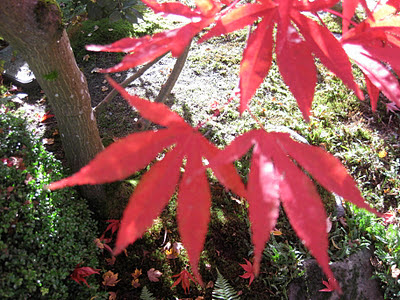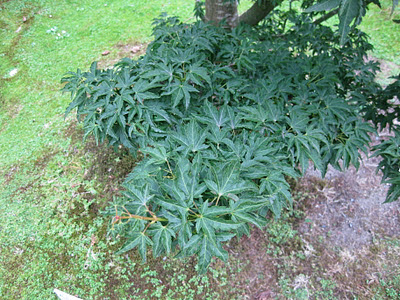by aleks
Click on the pics to see them larger
Here are the remaining maples which were marked by name for the Maple Fest Oct. 16, and are still performing their magic tricks, while awaiting your visit.
8.) Acer palmatum 'Yatsubusa' - dwarf leaf maple:
Native of Japan, it sits on the right side of the entrance path, right before paperbark maple and it has exceptionally small and dainty leaves. I googled it to see for fall color patterns, only to be dazzled by too many varieties: mikawa yatsubusa, kiyohime yatsubusa (ground cover type), kashima yatsubusa, shishi yatsubusa.... I think I felt a bit better before getting a glimpse of the depth of my ignorance; well - most of them get orange-red leaves in autumn and some get red tips or edges, but ours is still firmly green.
 |
| SJG • 10/19/11 - Acer palmatum 'Yatsubusa' - dwarf leaf maple, it's the green tree in the center, between bench and pine, Area C |
 |
| SJG • 10/19/11 - Acer palmatum 'Yatsubusa' - dwarf leaf maple, tiny leaves |
9.) Acer sieboldianum - Siebold maple:
Never really noticed much this modest maple, which sits in out of the way, between the paths place, in area F. But now it is, ah, so strikingly beautiful, leaning over the water in her autumn brilliant orange and red regalia... It's native to the mountains of Japan.
 |
| SJG • 10/19/11 - Acer sieboldianum - Siebold maple, Area F |
 |
| SJG • 10/19/11 - Acer sieboldianum - Siebold maple, leaves |
10.) Acer nikoense - Nikko maple:
We had really hard time to find it: Sue - the Master Gardener and 3 of us, guides, walked along the service road several times back and forth trying to locate it, to no avail... We finally discovered it on the edge of the orchard - fortunately it had the official green Park label attached, so we were sure it was IT.
Originally we were under-impressed - another maple not looking like a Japanese maple at all, just a big, green tree - but the next day Sue mentioned that she and Patty read up on it, and that once in fall color it is supposed to be spectacular - so we will all look forward to it. Also Keiko emailed that she didn't recognize it because it wasn't looking like magnificent Nikko maples she saw in Japan, and only later she remembered Kathleen Smith's maple lecture/tour some years ago and stopping by this particular tree, even making a drawing of its branches then. Apparently wait and see attitude is needed, before we are gifted with what this native of China and Japan does in autumn while living in the Pacific Northwest climate. I'll try to photograph it some more, as the fall progresses...
 |
| SJG • 10/19/11 - Acer nikoense - Nikko maple, the green tall one in the middle, between orange tree on the left and smaller orchard tree on the right, Area ZZW |
 |
| SJG • 10/19/11 - Acer nikoense - Nikko maple, tri-foliate leaves which turn pinkish-red-purple in fall and separate as they fall; found a branch that is slowly turning |
 |
| SJG • 11/1/11 - Acer nikoense - Nikko maple, tri-foliate leaves 2 weeks later |
11.) Acer palmatum 'Samidare' - Japanese maple:
This native of Japan resides next to the zigzag bridge and, like most maples this year, is late turing - last year it was bright red for the Maple Fest and I remember clicking lots of pics of it (one small sits on the top left column of this blog). Its leaf has seven lobes and branches turn different shades of orange, red and purple in autumn.
 |
| SJG • 10/19/11 - Acer palmatum 'Samidare' - Japanese maple, Area Q |
 |
| SJG • 10/19/11 - Acer palmatum 'Samidare' - Japanese maple, leaves |
12.) Acer Palmatum 'Omato' - Japanese maple:
Located between wisteria trellis and the East fence, 7 lobes Omato has leaves that in spring are bright red, turn to green in the summer and then turn deep red again in the late autumn.
 |
| SJG • 10/19/11 - Acer Palmatum 'Omato' - Japanese maple, Area K |
 |
| SJG • 11/1/11 - The same Acer Palmatum 'Omato' - Japanese maple, 2 weeks later getting crimson red again |
 |
| SJG • 10/19/11 - Acer Palmatum 'Omato' - Japanese maple, leaves |
 |
| SJG • 11/1/11 - Acer Palmatum 'Omato' - Japanese maple, leaves, 2 weeks later |
13.) Acer palmatum 'shishigashira' - Lion's mane maple:
Sometimes referred to as 'Lion's Head Maple', it holds its foliage in interesting tufts. Native of Japan, Shishigashira lives on the mountain path leading to the North Hill, above the village. Its densely packed small leaves have 7 lobes, and it is usually one of the last to flaunt its golden orange and crimson tones in autumn.
 |
| SJG • 10/19/11 - Acer palmatum 'shishigashira' - Lion's mane maple Center left in the pic - holds its foliage along the branches in bundles, giving it bold architectural appeal; Area N. |
 |
| SJG • 10/19/11 - Acer palmatum 'shishigashira' - Lion's mane maple |
14.) Acer circinatum - vine maple:
Ooops, or what is left of it this year - this native to NW US already turned and adjourned :( - will ask the Gardeners if it's normal and look for the others, as there are 6 vine maples in the Garden...
Wiki entry says that it grows from southwest British Columbia to northern California, always within 300 km of the Pacific Ocean coast. The enigmatic description provided for the Maple Fest reads: 'Leaves have 5-11 lobes and can turn brilliant orange red'. CAN? Meaning might not or do something else? Oh, well, missed whatever it did, but found some leaves on the ground still.
 |
| SJG - 10/19/11 - Acer circinatum - vine maple; already turned and adjourned, Area Y |
 |
| SJG - 10/19/11 - Acer circinatum - vine maple, leaf (on the ground the tree bare) |
15. Acer palmatum 'Shigitatsusawa':
Sometimes spelled 'Shigitatsu Sawa', this maple grows in the shaded area (it doesn't like intense sun) along the service road on the West side of the Garden. It has reticulated leaves (which appear variegated due to the contrast created between leaf surface and the prominent leaf veins) with 7-9 lobes, pale green in spring changing to a medium green in summer with a less defined vein. Fall color is golden yellow with a contrasting vein.
 |
| SJG • 10/19/11 - Acer palmatum 'Shigitatsusawa', Area ZZW |
 |
| SJG • 10/19/11 - Acer palmatum 'Shigitatsusawa', leaves |
16. Acer griseum - Paper-bark maple:
Almost forgot you, dear paper-bark maple, because your fascinating peeling bark is pointed to all year round - walked right past and had to go back to get a pic...
Our paper-bark maple sits close to the entrance of the Garden, in area C - it's a tall, mature tree, with leaves not resembling typical maple, and too high in the sky for my camera to capture them.
 |
| SJG • 10/27/11 - Acer griseum - Paper-bark maple, peeling bark trunk |
• • • • • • • • • • • • • • • • • • • • • • • • • • • • •
About all those interesting Japanese names of the maples - hopefully, it'll be in the next post. Keiko, are you ready? Fascinating what you said that 'Shigitatsusawa' means 'shigi bird standing near the water' (if I recall correctly this beautiful image), and that shigi is something between egret and tashigi, a rice field shigi? I'll email you the list of maple names soon, and possibly we can start from there - can't wait for this linguistic adventure.


No comments:
Post a Comment
Note: Only a member of this blog may post a comment.